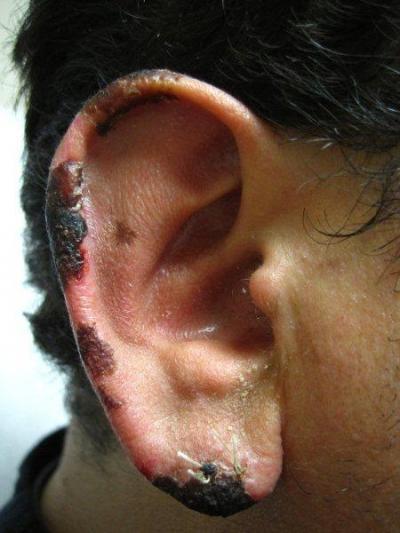LOS ANGELES—(June 20, 2011)—Doctors warned of a potential public health epidemic in a recent report on patients in Los Angeles and New York who developed serious skin reactions after smoking or snorting cocaine believed to be contaminated with a veterinary medication drug dealers are using to dilute, or "cut," up to 70% of the cocaine in the U.S.
The report, published online in the Journal of the American Academy of Dermatology, said six patients developed purple-colored patches of necrotic skin on their ears, nose, cheeks and other parts of their body and, in some instances, suffered permanent scarring after they had used cocaine.
Doctors in San Francisco had previously reported two similar cases there. Others have also reported on users of contaminated cocaine who developed a related life-threatening immune-system disorder called agranulocytosis, which kills 7% to 10% of patients.
The U.S. Department of Justice has reported that up to 70% of cocaine in the U.S. is contaminated with the drug, levamisole, which is cheap, widely available and commonly used for deworming livestock. Levamisole had been prescribed for humans in the past but was discontinued after developing side effects similar to those found in the cocaine users.

Doctors warn of a potential public health epidemic after treating patients with serious skin reactions after the patients had smoked or snorted cocaine believed to be contaminated with a veterinary medication.
(Photo Credit: Dr. Noah Craft)
"We believe these cases of skin reactions and illnesses linked to contaminated cocaine are just the tip of the iceberg in a looming public health problem posed by levamisole," said Noah Craft, MD, PhD, a Los Biomedical Research Institute at Harbor-UCLA Medical Center (LA BioMed) principal researcher and author of the report in the Journal. "We published this report to educate the public to the additional risks associated with cocaine use and to increase awareness among physicians who may see patients with these skin reactions that are a clue to the underlying cause of the disease. Because this reaction can commonly be mistaken as an autoimmune disease called vasculitis, it is important for physicians to know about this new disease entity."
Dr. Craft said he and other physicians were initially baffled by the severity of the skin damage. He is a member of a team of doctors who advise Logical Images, a company that developed a software program, called VisualDx, for diagnosing skin diseases and other conditions.
During one of their conference calls in May 2010, Dr. Craft said they began discussing the skin damage seen in emergency rooms in New York and Los Angeles and realized they were all seeing similar patterns and that the one common thread was the use of cocaine prior to the development of the skin damage. The cases were pooled and added into the professional database immediately so that other physicians across the US were then able to see this new diagnosis.
"We have had several more cases since we wrote this report," he said. "In one of the more interesting ones, the patient used cocaine again and developed the same skin reaction again. He then switched drug dealers and the problem cleared up."
Source: Los Angeles Biomedical Research Institute at Harbor-UCLA Medical Center (LA BioMed)